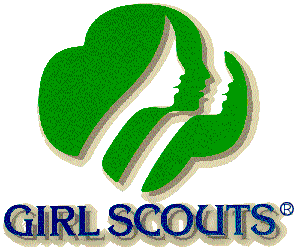

Troop 1440
Wakefield, MA

| Girl Scouts USA | Cookie Sale 2001 / 2000 / 1999 / 1998 / 1997 | Home Page |
| Girl Scout Promise / Law | Calendar 2001 / 2000 / 1999 / 1998 / 1997 | Troop 2001 / 2000 / 1999 / 1998 / 1997 |
| About Girl Scouts | The Five Worlds Juniors / Brownies | Activities 2001 / 2000 / 1999 |
| Glossary / History / Songs | Sign / View Guest Book | Links |
 |
|
 |
![]()
We sold girl scout cookies and we exceeded our goal of 700 boxes by more than 250! We had two booth sales at a local video store and sold 113 boxes there. We sold 863 boxes at our door to door sales! Look below the cookies to see how many of each flavor we sold. Those Thin Mints sure are popular! |
|||||||
 |
 |
 |
 |
 |
 |
 |
 |
| 64 | 89 | 132 | 265 | 55 | 101 | 93 | 64 |
| boxes | boxes | boxes | boxes | boxes | boxes | boxes | boxes |
| We earned $374.79 for our troop! We're going to make a donation to a charitable organization in Wakefield and we're going camping Memorial Day Weekend at the Wakefield Service Unit's Encampment. We still have to figure out what we're going to do with the rest of the money! | |||||||
![]()
![]()
The purpose of the Girl Scout Cookie sale is twofold: it helps girls develop leadership skills and practice resourcefulness and self-reliance and it generates revenue for troops and Girl Scout councils to fund the time-honored Girl Scout program in the United States.
![]()
Girls benefit from participating in the Girl Scout Cookie sale in a variety of ways. They are members of a team, working towards a common goal, with each girl striving to do her best. Girls also practice other useful skills, such as earning money for troop activities, learning to take orders in a businesslike way, handling money, delivering goods in top condition, knowing the satisfaction of a job well done.
Every penny earned by cookie sales remains in the locality where the cookies were sold; no money earned by girls is sent to the national Girl Scout office. All cookie income is used to benefit girls, some directly by remaining in the troop treasury and some indirectly by subsidizing the cost of Girl Scout camps and other programs in the local area.
Cookie sale earnings help bridge the gap between income from other sources, such as gifts, bequests, and other fund raising, and the money required to provide Girl Scouting in the community. Funds help local Girl Scout troops engage in a wide variety of activities, field trips, and service projects. Funds from cookie sales help councils recruit and train the volunteer leaders for each troop, provide financial assistance to make Girl Scouting available to girls of modest means, improve and maintain campsites, and subsidize local program opportunities.
"Cookie money" has kept camp fees for everyone to a minimum and supported a variety of other council and troop activities. Or, as the label on the cookie box itself states, "The annual cookie sales give the Girl Scouts an opportunity to earn money for program activities, for special events and projects, and for purchasing and maintaining equipment and facilities."
Girl Scout councils set their own cookie prices based on program needs and their knowledge of local markets, so the price per box may vary from one place to another and from one year to the next. While Philadelphians in 1934 paid 23 cents per box of 44, or six boxes for $1.24, today's prices reflect both the current cost of cookies and the realities of providing program in an ever-changing social environment.
The Girl Scout Cookie sale is a part of Girl Scout heritage and tradition. It is an important part of what makes Girl Scouting an institution in the United States.
![]()
The origins of the Girl Scout Cookie are somewhat shrouded in the mists of time. One legend has it that the precursor of today's Girl Scout Cookie was a homemade "biscuit" baked and sold by troops of Girl Guides in England in the early part of this century. Shortly after Juliette Low's founding of the Girl Scouts in the United States in 1912, unnamed troops were busy baking and selling cookies.
Homemade cookies were probably sold as part of individual troop money earning projects with some of these "kitchen industries" growing into fairly well-organized volunteer efforts. Various reports have claimed Buffalo (1931), Illinois 1932), Connecticut, and Pennsylvania (the early 30s), as having been the site of the first major cookie push; no one knows for certain.
What is known is that Girl Scout councils countrywide had their interest piqued by a report on one group's activities in the January 1928 Girl Scout Leader magazine, boasting "cookie sales have yielded as much as $1,400 at a time" -- a substantial amount of money for that period.
They were assisted in their efforts to perfect an attractive, uniform, and truly professional-looking cookie by the appearance of an official trefoil cookie cutter, made of frosted aluminum and offered for 15 cents in the March 1932 Girl Scout Leader: "Trefoil cookie cutter! Every Girl Scout and troop will want one..."
One of the first organized cookie-selling efforts began in Philadelphia. There in 1933, one group of Girl Scouts displayed their business enterprise by persuading the Philadelphia Gas Company and the Philadelphia Electric Company to permit them to use the companies' store windows to display and sell cookies.
In 1934, the president of the Girl Scout council in Philadelphia approached a local baking company who agreed to bake and package vanilla Girl Scout Cookies in the trefoil shape. This was the first council-wide sale of commercially baked and packaged Girl Scout Cookies in the U.S. Other nearby councils impressed by Philadelphia's success soon asked to be included in their bakery order.
By 1938, the volume of council-wide sales was so large and its attendant complications so many that the national organization, Girl Scouts of the U.S.A. (GSUSA), assumed responsibility for licensing those firms which would do the baking and boxing of Girl Scout Cookies using the Girl Scout name and insignia. Licensing on a centralized basis insured standardized quality products combined with uniform packaging and distribution procedures.
What Happens Now
There are presently two bakeries licensed by GSUSA to produce Girl Scout Cookies. Bakers are judged on their ability to produce high-quality products and the caliber of their production facilities. They must submit samples for tasting and file their recipes with GSUSA; recipes must meet specific nutrition standards.
The emphasis is on product quality. Bakers have made strenuous efforts to reduce the use of artificial flavors and colors, and both bakers now provide non-fat, low-fat, and reduced-fat varieties. During baking season, they are required to send sample cases of their cookies to the national office, which maintains regular quality control checks, approves selling aids for local Girl Scout councils and sets standards for packaging. In deciding which of the licensed bakers to use, councils will conduct their own taste-tests, scrutinize recipes and run periodic quality control checks of their own.
Girl Scout Cookie suppliers are required to offer councils three basic cookie types: chocolate mint (the most popular), the trefoil-shaped shortbread, and a sandwich cookie. They also must offer at least three optional types and one Kosher cookie and may, depending upon the council's inclination, come up with as many as seven cookies altogether.
Who Is Involved
Girl Scout Cookie sales are achieved through close cooperation of manufacturers, GSUSA, the councils, volunteers, staff, the girls themselves, and parents, as well as other family members and friends; and of course, our loyal Girl Scout Cookie customers!
It has been estimated that more than two million Girl Scouts take part in cookie sales. They belong to over 160,000 troops in 321 Girl Scout councils across the United States. For safety's sake, all Girl Scouts who take part must provide written proof of parental consent and must receive training in cookie sales procedures.
In addition to selling cookies to friends and neighbors, troops sometimes sell directly to customers in booths specifically erected in shopping malls, department stores, and corporate office buildings sometimes in conjunction with Girl Scout Week (March 12). Similarly, councils train adult volunteers in cookie sales management. Many months of preparation lead up to a council's "cookie week" or weeks, and some offer mini-courses. Skills required include estimating orders, ordering, storing, distributing to troops, collecting money from sales, keeping records and generating publicity.
Families, particularly parents, are often involved through helping to check figures, picking up and delivering cartons, providing support and encouragement to girls who sell.
![]()
|
|
Some of the graphics on this page are courtesy of Graphmaster |
 |
|||||||
| ©
Copyright 1988 - 2003 by Dana J. Montgomery. Copying of this web page in
whole or in part (logo, images, text, etc.) is prohibited without express
written permission of Dana J. Montgomery. |
|||||||||
|
|
||||||||